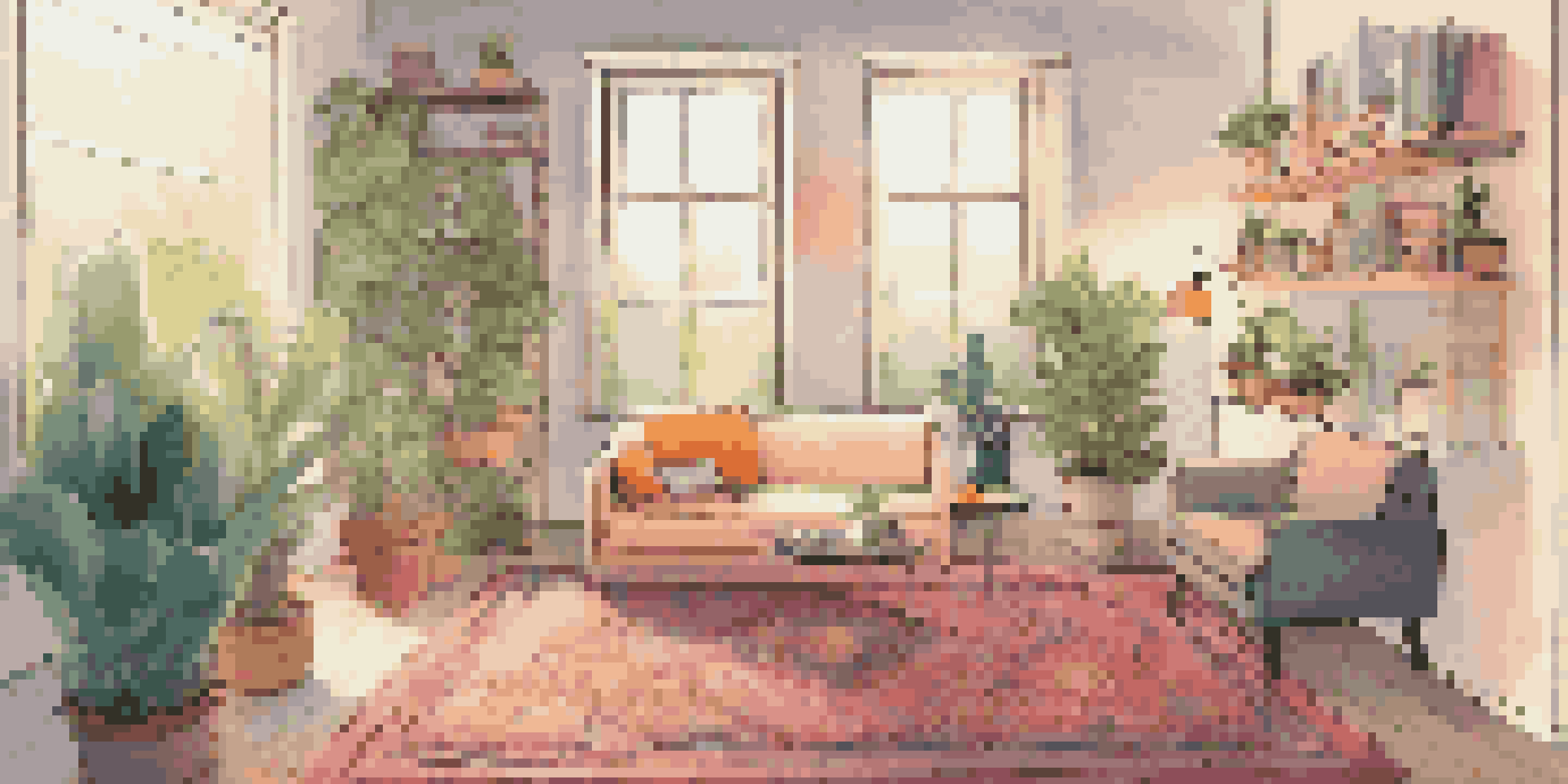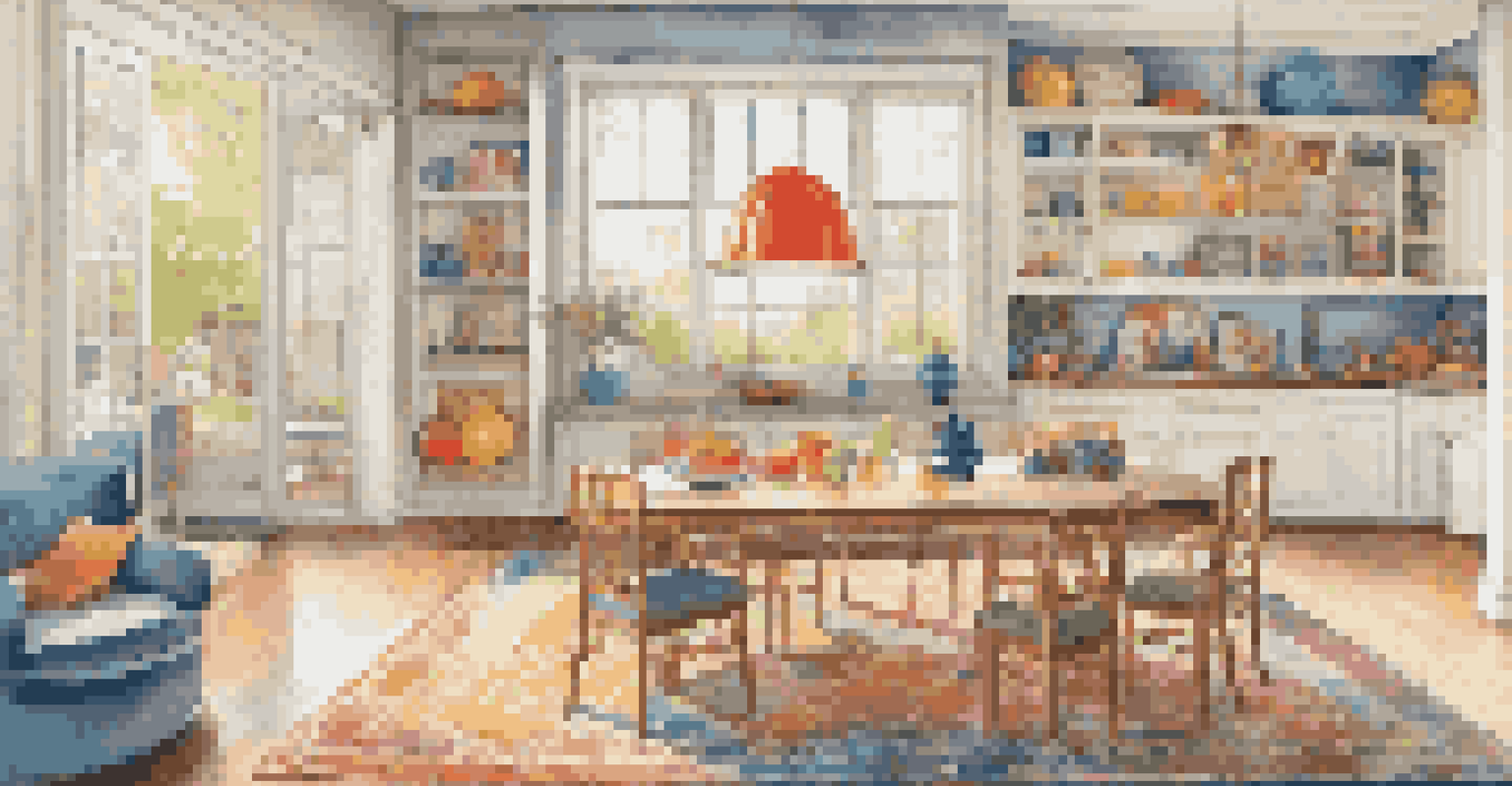Creating Multi-Use Spaces in Open Floor Plans: Design Ideas

Understanding the Benefits of Multi-Use Spaces
Multi-use spaces are a game changer in modern design, especially in open floor plans. They allow homeowners to maximize functionality without sacrificing style. Imagine having a living room that seamlessly transforms into a workspace or a play area in seconds; that’s the beauty of multi-use spaces.
The best rooms have something to say about the people who live in them.
Besides enhancing practicality, these spaces can also foster a sense of community within the home. Families can engage in different activities simultaneously while still being connected. This flexibility not only caters to individual needs but also brings everyone together.
Moreover, multi-use spaces can significantly increase the value of your home. Potential buyers often look for versatility when house hunting. When they see well-designed areas that serve multiple purposes, it can make your property stand out in a competitive market.
Choosing the Right Furniture for Flexibility
Furniture plays a pivotal role in creating multi-use spaces. Opt for pieces that are lightweight and easy to move, such as nesting tables or foldable chairs. These allow you to rearrange your setup effortlessly to suit various activities, from a family gathering to a quiet reading nook.

Another smart choice is multifunctional furniture, like ottomans with storage or a sofa bed. These items not only save space but also offer extra functionality. For example, a sofa bed can transform your living room into a guest room overnight, perfect for unexpected visitors.
Maximize Space with Multi-Use Areas
Multi-use spaces enhance functionality and style, allowing homeowners to create versatile environments that cater to various activities.
It's also essential to consider the aesthetic appeal of your furniture. Choose designs that complement your overall decor while also being practical. This way, you can maintain a cohesive look throughout your space, even as you change its function.
Incorporating Zones with Rugs and Colors
One effective way to delineate spaces in an open floor plan is by using rugs and colors. A well-placed rug can define a specific area, such as a reading corner or dining space, making each function clear. This visual cue helps everyone in the home understand the intended use of each section.
The key to great design is capturing the spirit of the client and the essence of the space.
Additionally, using different color schemes can enhance this zoning effect. Consider painting one wall a bold color to signify a workspace or using softer tones in relaxation areas. This method not only adds visual interest but also creates distinct moods for each zone.
By combining rugs and color, you can create a harmonious flow throughout the space. This approach ensures that while each area serves a unique purpose, they all feel connected. It’s a simple yet effective strategy to enhance the overall design of your multi-use space.
Utilizing Vertical Space for Storage Solutions
In open floor plans, vertical space often goes underutilized. Installing shelves or cabinets that reach up to the ceiling can help maximize storage while keeping the floor area clear. This allows you to store items out of sight, creating a more organized and spacious environment.
Consider using wall-mounted organizers for smaller items, such as office supplies or craft materials. This not only keeps essentials accessible but also frees up valuable surface space. Vertical storage solutions can blend seamlessly with your decor, providing both function and style.
Smart Furniture Choices Matter
Selecting lightweight and multifunctional furniture is essential for creating flexible spaces that adapt to changing needs.
Moreover, incorporating plants or artwork on higher shelves can add personality to your space. This strategy not only enhances your decor but also utilizes every inch of your home effectively. Vertical storage is a smart way to keep your multi-use spaces both functional and visually appealing.
Creating Flexible Lighting Solutions
Lighting is crucial in multi-use spaces, as it sets the mood for different activities. Layering your lighting with ambient, task, and accent lights can create a versatile atmosphere. For instance, use soft overhead lighting for relaxation and bright task lighting for work or study areas.
Consider incorporating dimmable lights or smart bulbs, which allow you to adjust brightness levels with ease. This flexibility means you can create the perfect environment for whatever you’re doing, whether it’s hosting a dinner party or enjoying a quiet movie night.
Don’t forget natural light, which can make any space feel more inviting. Strategically placing mirrors can help reflect light throughout the room, making it feel even more open. By thoughtfully planning your lighting, you enhance the functionality and ambiance of your multi-use spaces.
Incorporating Nature for a Calming Effect
Bringing nature indoors can significantly enhance the atmosphere of multi-use spaces. Houseplants not only purify the air but also add a touch of tranquility to your home. Imagine working in a space filled with greenery; it’s a refreshing change from sterile environments.
You can also consider using natural materials, such as wood or stone, in your decor. These elements create a warm and inviting feel, making your space more comfortable for various activities. For example, a wooden coffee table can serve as a functional piece while adding to the overall aesthetic.
Personal Touches Enhance Design
Incorporating personal elements, like artwork and hobbies, makes multi-use spaces feel inviting and reflective of your unique lifestyle.
Moreover, incorporating large windows or glass doors can help you stay connected to the outdoors. This connection can boost your mood and productivity, making your multi-use space more enjoyable. Embracing nature is a simple yet powerful way to enhance the design of your home.
Personalizing Your Multi-Use Space
Personalization is key to making any space feel like home. Displaying your favorite artwork or family photos can infuse character into your multi-use areas. These personal touches create a sense of belonging, making the space more inviting for both you and your guests.
Consider creating a gallery wall that reflects your interests and experiences. This not only adds visual interest but also becomes a conversation starter. A well-curated space tells a story about who you are while accommodating various functions.

Don’t shy away from incorporating hobbies into your decor. Whether it’s a cozy reading nook filled with books or a corner for your craft supplies, making space for your passions ensures that your multi-use areas are both functional and reflective of your lifestyle.